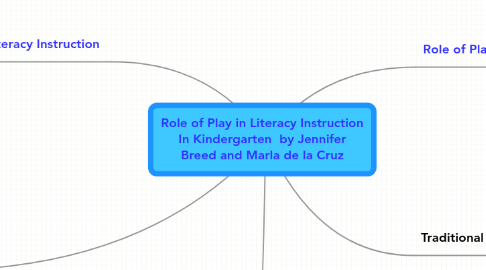
1. Literacy Instruction
1.1. Phonemic Awareness
1.1.1. Begins ineutero (The Baby Human video)
1.1.2. Focuses on sound manipulation (Helping Young Children Learn the Language of Literacy)
1.1.2.1. Onset/rime
1.1.2.2. Syllables
1.1.2.3. Phoneme addtion/deletion/substitution
1.1.2.4. Initial, medial, final sounds
1.1.3. Can be practiced given the opportunity to have conversations (RDG 525 video clips)
1.1.3.1. Dramatic play
1.2. Phonics
1.2.1. Involves sound symbol relationship
1.2.2. Must be systematic and explicit
1.3. Fluency
1.3.1. Directly linked to comprehension (Put Reading First)
1.3.1.1. Can be taught using readers theater (RDG 525 presentation)
1.4. Vocabulary
1.5. Comprehension
1.5.1. the reason to read
2. New Academic Kindergarten
2.1. Full day
2.1.1. time to expand on teaching
2.2. Reading Basals "with fidelity"
2.3. Testing
2.3.1. DIBELS or other testing that must be reported to the state.
2.4. Expected to read, write, recognize sight words, numbers up to 30, addition and subtraction.
2.5. The New First Grade
2.5.1. Has evolved because we now know mare about how young children learn. (Newsweek article, Peg Tyre, "The New First Grade..." September 11, 2006)
2.6. No Child Left Behind Act
2.6.1. To level the academic playing field for all children regardless of socioeconomic levels or where the school is located.
2.6.2. Holding the school accountable or risk being shut down, lose funding, or even lose teachers and principals jobs.
3. Goal of Kindergarten is still the same, regardless of the "new first grade" or traditional. To build lifelong good feelings about learning and school.
4. Role of Play
4.1. Dramatic Play
4.1.1. Authentic Literacy (module 4 presentation RDG 525)
4.1.2. Vocabulary Devlopment
4.1.3. Phonemic Awarness (RDG 525)
4.2. New node
4.3. Theories of Play
4.3.1. Vygotsky says play has 2 critical features (Power Point Presentation from ECD505)
4.3.1.1. Creates an imaginary situation where childrne can "act out" their fears and unknowns.
4.3.1.2. Contains rules that children must master in order to be successful in the "real world"
4.4. Litercacy Center (Helping Yound Chidlren Learn the Language of Literacy)
4.4.1. Literacy centers focus on only literacy type activities to help children. Writing centers, classroom library, games (letter matching, memory type), puzzles.
5. Traditional Kindergarten
5.1. Half Day
5.1.1. Limited time
5.1.1.1. In the past, focused on socialization and early skills.
5.1.1.2. Focus on learning the alphabet and other basic skills
5.1.1.3. Play based
